Brazil Surveillance IP Cameras Market Size
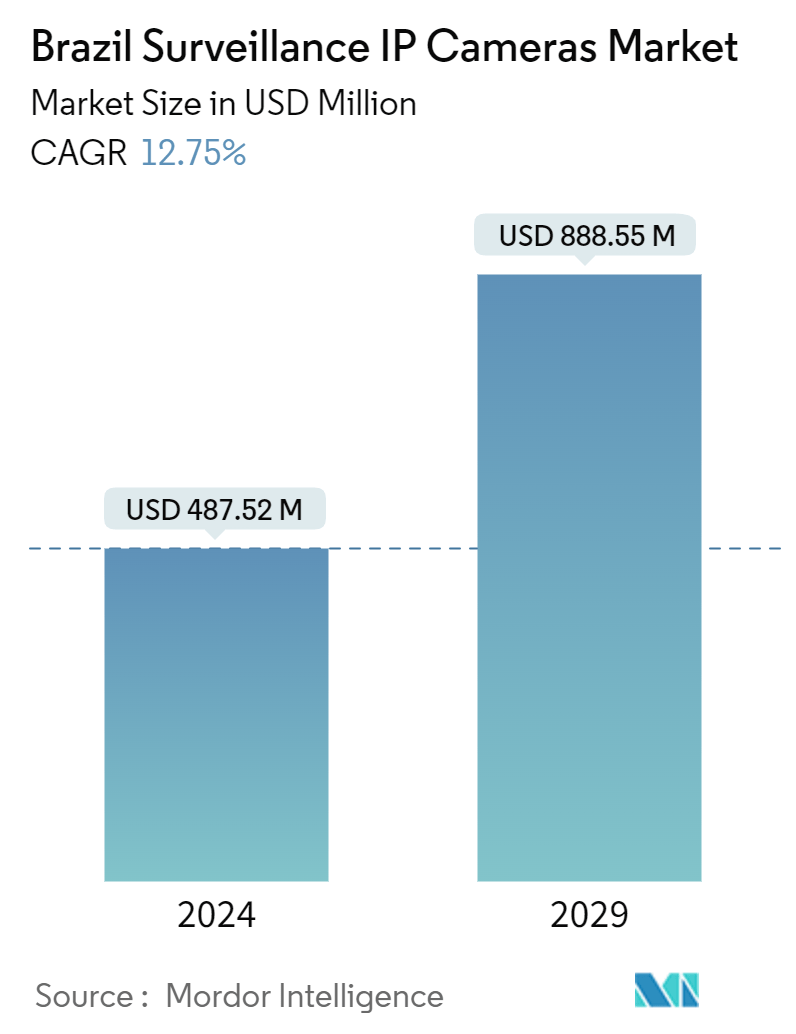
| Study Period | 2019 - 2029 |
| Base Year For Estimation | 2023 |
| Market Size (2024) | USD 487.52 Million |
| Market Size (2029) | USD 888.55 Million |
| CAGR (2024 - 2029) | 12.75 % |
| Market Concentration | Low |
Major Players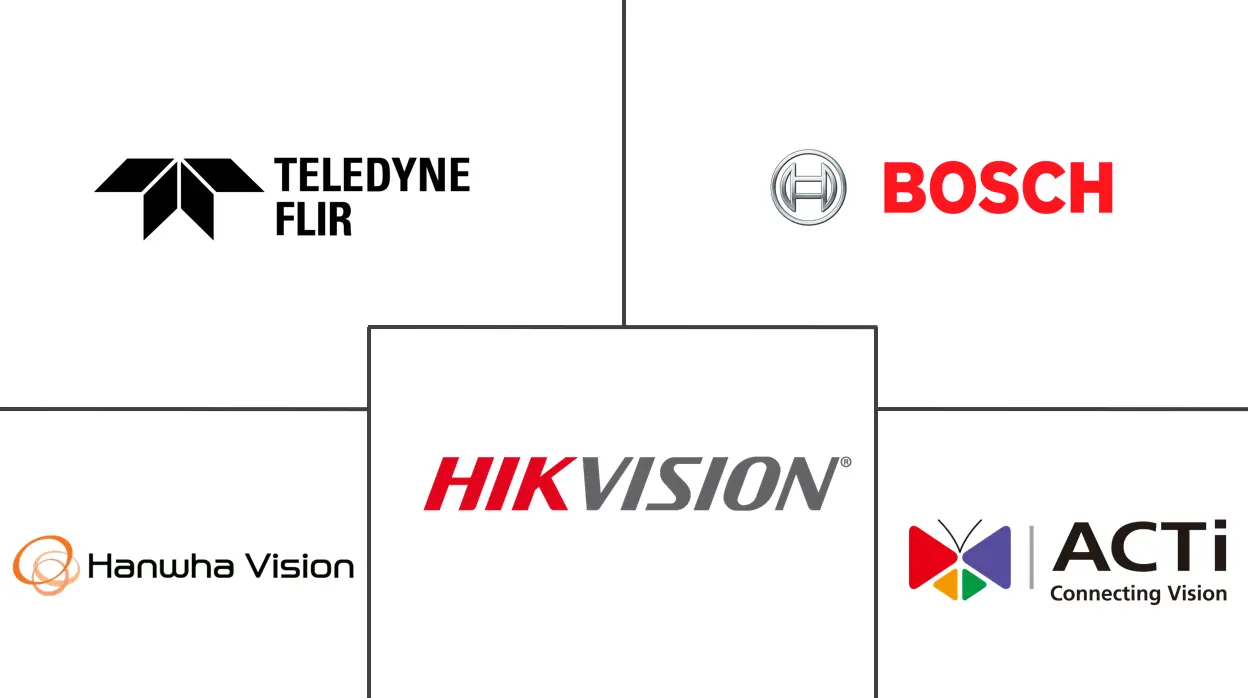
*Disclaimer: Major Players sorted in no particular order |
Brazil Surveillance IP Cameras Market Analysis
The Brazil Surveillance IP Cameras Market size is estimated at USD 487.52 million in 2024, and is expected to reach USD 888.55 million by 2029, growing at a CAGR of 12.75% during the forecast period (2024-2029).
- Over the years, the transition from analog to IP cameras has spurred a demand for high-resolution models, resulting in clearer images and enhanced surveillance capabilities. Moreover, the incorporation of AI in IP cameras introduces advanced functionalities such as facial recognition, behavior analysis, and anomaly detection.
- Escalating crime rates and emerging security threats have intensified the demand for robust surveillance systems. For example, urban centers grappling with elevated crime rates are increasingly adopting IP cameras to bolster public safety. Furthermore, the surge in urbanization and the heightened security needs of commercial establishments are propelling the demand for surveillance IP cameras.
- Brazil's ambition to cultivate smart cities has catalyzed the widespread adoption of IP surveillance systems. Major cities like Sao Paulo and Rio De Janeiro are embedding sophisticated surveillance systems into their smart city frameworks, focusing on traffic monitoring, public space management, and safety assurance.
- In a bid to combat rising crime rates, the Brazilian government has rolled out several initiatives. Highlighting its commitment, in October 2023, the government unveiled a national security program targeting organized crime, especially in light of a recent uptick in violence. A key objective is to bolster police efficiency, with authorities earmarking approximately USD 174 million for the 2024-2026 period.
- Brazil's substantial investments in public infrastructure projects are set to drive opportunities in the surveillance IP cameras market, as they are prominently used across public and commercial infrastructure. In August 2023, the Brazilian government unveiled plans to allocate over USD 200 billion to infrastructure, energy, and transportation from 2024 to 2027.
- As surveillance systems, particularly those utilizing facial recognition technology, become increasingly prevalent, they raise significant privacy concerns. Critics underscore the risk of these systems encroaching on citizens' rights, potentially resulting in data misuse and privacy violations. The recent installation of thousands of facial recognition cameras in Sao Paulo has amplified these concerns. Opponents contend that the blanket use of this technology could exacerbate challenges like structural racism and inequality, in addition to jeopardizing data privacy and cybersecurity. Consequently, these trends pose challenges to the market's growth during the forecast period.
Brazil Surveillance IP Cameras Market Trends
Higher Crime Rates and Growing Consumer Awareness Driving the Market
- As consumers and businesses become more aware of security risks and the advantages of surveillance systems, adoption rates continue to rise. The plummeting costs of IP cameras are broadening their appeal, making them accessible not just to large enterprises but also to small businesses and residential users. Furthermore, e-commerce platforms like Mercado and Amazon are making it easier for consumers to access and purchase these cameras, further fueling market expansion.
- There are approximately 30 million MSMEs in Brazil that are becoming increasingly aware of security due to the high rate of crimes, robberies, etc. Rapid urbanization, which was approximately 87.79% in 2023, and the development of new residential and commercial properties create opportunities for deploying modern surveillance.
- The growing adoption of smart home technologies is driving the demand for IP cameras, which offer remote monitoring and control through smart home platforms. Retailers are investing in IP cameras to prevent theft, monitor customer behavior, and ensure the safety of staff and customers. According to data gathered by CNC, the total number of stores, including electronics, supermarkets, wholesalers, and fashion retailers, reached 2.5 million in 2023, representing a growth rate of 8.1% compared to 2022.
- Despite a slowdown in crime rates, the cities in the country still grapple with crimes. Notably, cities like Feira de Santana, Manaus, Salvador, Recife, and Macapa report homicide rates exceeding 40 per 100,000 inhabitants. In 2023, the northeast region of Brazil was home to seven of the ten cities with the highest homicide rates. Feira da Santana topped the list as Brazil's most violent city, recording a murder rate of 58.69 per 100,000 inhabitants.
- The market is driven by a combination of factors, such as stubborn crime rates, technological advancements, the rise of smart homes and commercial spaces, consumer awareness, and favorable economic conditions. As these factors continue to evolve, the demand for advanced IP surveillance systems is expected to grow, ensuring enhanced security and safety across various sectors in Brazil.
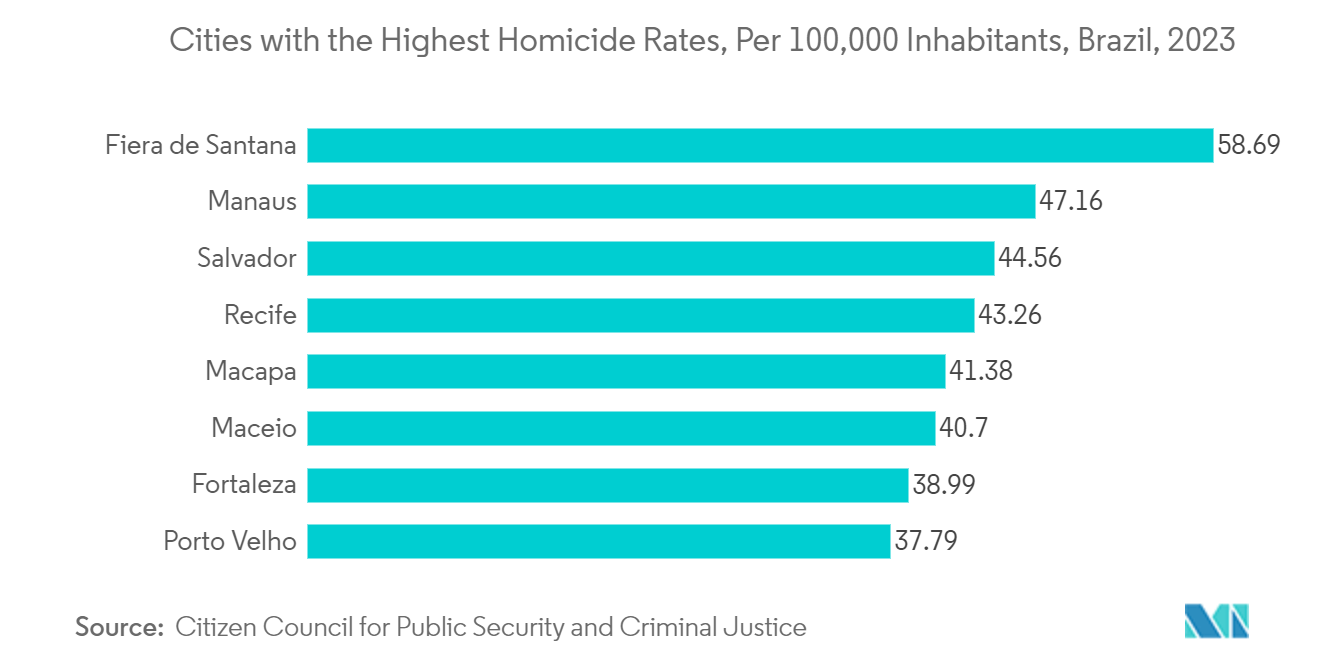
The Government Segment Witnessing Growth in Demand
- The Brazilian government is spearheading smart city initiatives, leveraging advanced technologies like IP cameras to enhance urban management. These surveillance cameras play a pivotal role in traffic management, monitoring public areas, and safeguarding residents. A prime example is the 2023 launch of the Smart Sampa Project, part of a broader suite of initiatives deploying modern surveillance techniques across various Brazilian states.
- The project is set to unveil a unified video surveillance platform, streamlining operations for emergency services, traffic management, the city's public transport, and police forces. By 2024, the plan is to install 20,000 new cameras, seamlessly integrating an equal number of third-party and private cameras into the network.
- These cameras are expected to oversee schools, medical facilities, and public areas like parks and squares. The integration of real-time analytics with facial recognition technology, powered by AI algorithms to detect and compare faces, aims to accelerate the identification of wanted criminals, stolen vehicles, missing individuals, and lost items while enhancing public transport management throughout the city.
- Thievery and robbery rank among the most prevalent crimes in Brazil. Data from the Ministry of Defense revealed that in 2023, Sao Paulo recorded 578,278 cases of theft and 221,955 instances of robbery. Concurrently, government expenditure on public infrastructure witnessed a consistent uptick, culminating in a notable USD 8.33 billion in 2023.
- Both federal and state governments are channeling significant budgets into public safety, bolstering the demand for surveillance IP cameras. Municipal governments are also making strides in local surveillance initiatives. For example, smaller cities and towns are increasingly adopting IP cameras to bolster community safety and oversee vital infrastructure.
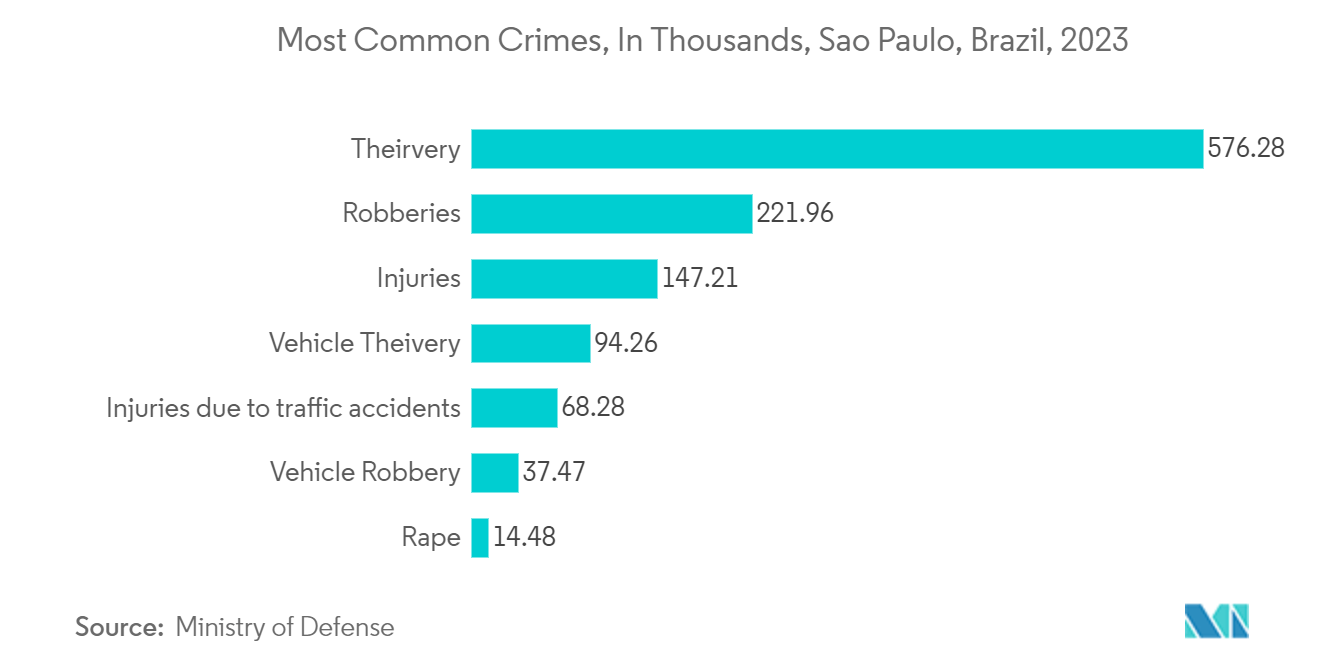
Brazil Surveillance IP Cameras Industry Overview
The Brazilian surveillance IP camera market is fragmented, with major players competing by offering technologically advanced products. The market features a wide range of manufacturers offering various technologies and solutions. Many companies compete in the market, offering various surveillance camera types and integration services. Some key market players include Teledyne FLIR, Hikvision, Hanwha Vision, and Bosch.
- April 2024 - Ajax Systems, a surveillance camera provider with a notable presence in Brazil, unveiled its newest line of wired security IP cameras. These cameras, rated at IP65 for both outdoor and indoor use, boast a passwordless authentication feature, ensuring a seamless and secure experience. Offering a range of matrix types and lenses, the camera lineup includes the DomeCam Mini, TurretCam, and BulletCam models.
Brazil Surveillance IP Cameras Market Leaders
-
Teledyne FLIR LLC
-
Hangzhou Hikvision Digital Technology Co., Ltd.
-
Hanwha Vision America
-
ACTi Corporation
-
Bosch Sicherheitssysteme GmbH
*Disclaimer: Major Players sorted in no particular order
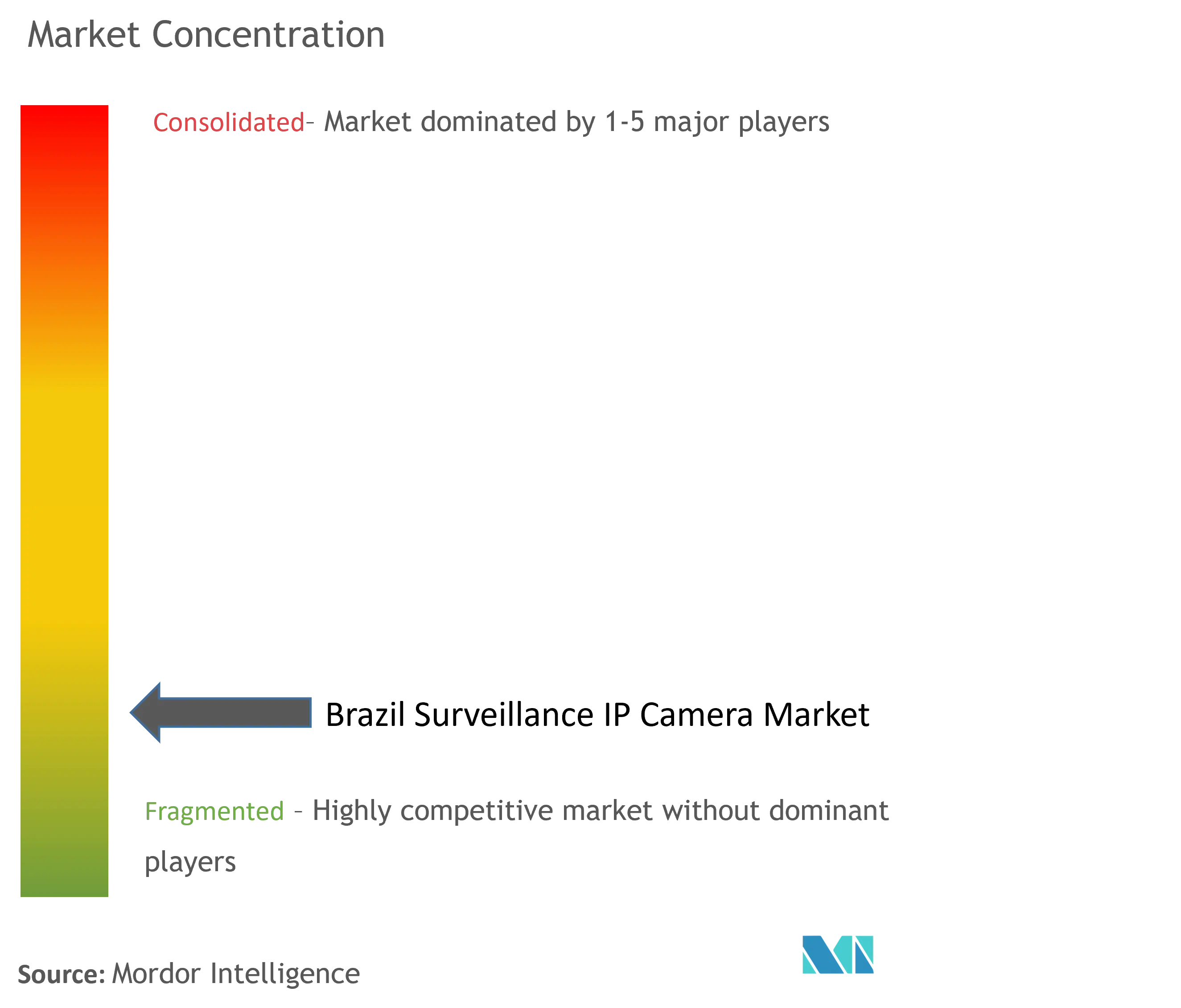
Brazil Surveillance IP Cameras Market News
- February 2024- Reolink unveiled an expanded lineup of 16 MP cameras, kicking off with the launch of the Reolink Duo 3 PoE camera. The new 16 MP series aims to tackle the common issues of low resolution and clarity that users often encounter with other mainstream dual-lens cameras. These enhanced dual-lens cameras boast features like image stitching for a full 180-degree view, the ability to capture detailed images from distances of up to 80 feet, and the innovative motion track.
- January 2024 - Hikvision, a global leader in security solutions, enhanced its camera range by introducing the Stealth Edition Cameras. These new additions, characterized by their black housings, not only offer a sleek aesthetic but also boast cutting-edge features. They include 24/7 full-color capabilities with ColorVu and advanced AI detection for both humans and vehicles through AcuSense. With their striking black finish, the cameras seamlessly blend aesthetics with innovative features, notably their pioneering AI video technology.
Brazil Surveillance IP Cameras Market Report - Table of Contents
1. INTRODUCTION
- 1.1 Study Assumptions and Market Definition
- 1.2 Scope of the Study
2. RESEARCH METHODOLOGY
3. EXECUTIVE SUMMARY
4. MARKET INSIGHTS
- 4.1 Market Overview
-
4.2 Industry Attractiveness - Porter's Five Forces Analysis
- 4.2.1 Bargaining Power of Suppliers
- 4.2.2 Bargaining Power of Consumers
- 4.2.3 Threat of New Entrants
- 4.2.4 Threat of Substitutes
- 4.2.5 Intensity of Competitive Rivalry
- 4.3 An Assessment of the Impact of Macroeconomic Trends on The Market
5. MARKET DYNAMICS
-
5.1 Market Drivers
- 5.1.1 Government Initiatives and Investments
- 5.1.2 Higher Crime Rates and Growing Consumer Awareness Driving the Market
-
5.2 Market Restraints
- 5.2.1 Privacy Concerns
6. MARKET SEGMENTATION
-
6.1 By End-user Industry
- 6.1.1 Banking and Financial Institutions
- 6.1.2 Transportation and Infrastructure
- 6.1.3 Government and Defense
- 6.1.4 Healthcare
- 6.1.5 Industrial
- 6.1.6 Retail
- 6.1.7 Enterprises
- 6.1.8 Residential
- 6.1.9 Other End-user Industries
7. COMPETITIVE LANDSCAPE
-
7.1 Company Profiles*
- 7.1.1 Teledyne FLIR LLC
- 7.1.2 Hangzhou Hikvision Digital Technology Co. Ltd
- 7.1.3 Hanwha Vision America
- 7.1.4 ACTi Corporation
- 7.1.5 Bosch Sicherheitssysteme GmbH
- 7.1.6 Pelco
- 7.1.7 Zhejiang Uniview Technologies Co. Ltd
- 7.1.8 IDIS Ltd.
- 7.1.9 Honeywell International Inc.
- 7.1.10 Panasonic Corporation
- 7.1.11 CP Plus
- 7.1.12 Axis Communications
8. INVESTMENT ANALYSIS
9. FUTURE OF THE MARKET
** Subject To AvailablityBrazil Surveillance IP Cameras Industry Segmentation
A surveillance IP camera is a digital video camera used for monitoring and security purposes. Unlike analog cameras, IP cameras transmit data over a network, allowing for remote viewing and recording. They often feature high-definition resolution, motion detection, and advanced capabilities such as facial recognition, night vision, and integration with other smart devices.
The study tracks the revenue accrued through the sale of surveillance IP cameras by various players operating in Brazil. The study also tracks the key market parameters, underlying growth influencers, and major vendors operating in the industry, which supports the market estimations and growth rates over the forecast period. The study further analyses the overall impact of macroeconomic factors on the market.
The Brazilian surveillance IP cameras market is segmented by end-user industry (banking and financial institutions, transportation and infrastructure, government and defense, healthcare, industrial, retail, enterprises, residential, and other end-user industries). The market sizes and forecasts are provided in terms of value (USD) for all the above segments.
| By End-user Industry | Banking and Financial Institutions |
| Transportation and Infrastructure | |
| Government and Defense | |
| Healthcare | |
| Industrial | |
| Retail | |
| Enterprises | |
| Residential | |
| Other End-user Industries |
Brazil Surveillance IP Cameras Market Research FAQs
How big is the Brazil Surveillance IP Cameras Market?
The Brazil Surveillance IP Cameras Market size is expected to reach USD 487.52 million in 2024 and grow at a CAGR of 12.75% to reach USD 888.55 million by 2029.
What is the current Brazil Surveillance IP Cameras Market size?
In 2024, the Brazil Surveillance IP Cameras Market size is expected to reach USD 487.52 million.
Who are the key players in Brazil Surveillance IP Cameras Market?
Teledyne FLIR LLC, Hangzhou Hikvision Digital Technology Co., Ltd., Hanwha Vision America, ACTi Corporation and Bosch Sicherheitssysteme GmbH are the major companies operating in the Brazil Surveillance IP Cameras Market.
What years does this Brazil Surveillance IP Cameras Market cover, and what was the market size in 2023?
In 2023, the Brazil Surveillance IP Cameras Market size was estimated at USD 425.36 million. The report covers the Brazil Surveillance IP Cameras Market historical market size for years: 2019, 2020, 2021, 2022 and 2023. The report also forecasts the Brazil Surveillance IP Cameras Market size for years: 2024, 2025, 2026, 2027, 2028 and 2029.
Brazil Surveillance IP Cameras Industry Report
Statistics for the 2024 Brazil Surveillance IP Cameras market share, size and revenue growth rate, created by Mordor Intelligence™ Industry Reports. Brazil Surveillance IP Cameras analysis includes a market forecast outlook for 2024 to 2029 and historical overview. Get a sample of this industry analysis as a free report PDF download.



